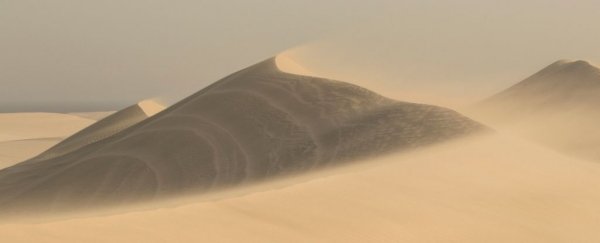Desert landscapes are not as lifeless as they look. Vast seas of sand dunes can not only grow, move, and interact with one another, a recent study suggests they can also 'breathe'.
Using a super-sensitive probe that took decades to invent, researchers have shown sand dunes regularly inhale and exhale tiny amounts of water vapor.
The inhales are harder to achieve when the sand is drier. But when the wind flows over the surface of a dune, it carries off the top layer, creating a rapid change in surface moisture and pressure. As a result, "evanescent waves of humidity" from the atmosphere above flow downward.
The probe used to detect this flow is so sensitive to moisture, it can pick up tiny films of water on a single grain of sand.
When plunged into a dune in the Qatar desert, the instrument was able to scan the temperature, radiation, and moisture in its surroundings on a millimeter-scale resolution in just 20 seconds.
These measurements were repeated every 2.7 minutes for two whole days, amassing a huge quantity of data.
The authors know of no other instruments that can keep tabs on a sand dune with such high spatial or temporal resolution.
In combination with data on wind speed and direction as well as ambient temperature and humidity, the authors have revealed an extremely subtle behavior of sand in the desert.
Unlike heat, which is conducted through individual sand grains, water vapor seems to percolate between grains.
The pores of a sand dune, therefore, carry moisture from the surface downward, and these pathways are made and remade as the wind blows.
"The wind flows over the dune and as a result creates imbalances in the local pressure, which literally forces air to go into the sand and out of the sand. So the sand is breathing, like an organism breathes," explains mechanical engineer Michel Louge from Cornell University.
This 'breathing' could be part of what allows microbes to live deep in sand dunes, even when no liquid water is available.
Interestingly, at the surface of the dune, the probe measured less evaporation than scientists were predicting. For such a hyper-arid region, the leaching of moisture from the sand dune to the atmosphere was a relatively slow chemical process.
"This is the first time that such low levels of humidity could be measured," says Louge.
The sensitivity of the new probe is a feat of technology that could allow scientists to more accurately measure how agricultural lands turn to desert, a process exacerbated by climate change.
"The future of the Earth, if we continue this way, is a desert," warns Louge.
Knowing more about how deserts work could, therefore, be really useful. And not just for a better understanding of our own planet.
Probes that can sensitively measure moisture within sand could help experts find invisible signs of water on, say, Mars.
Just because the desert looks deserted on the surface, doesn't mean there isn't life hiding below.
The study was published in the Journal of Geophysical Research: Earth Surface.
